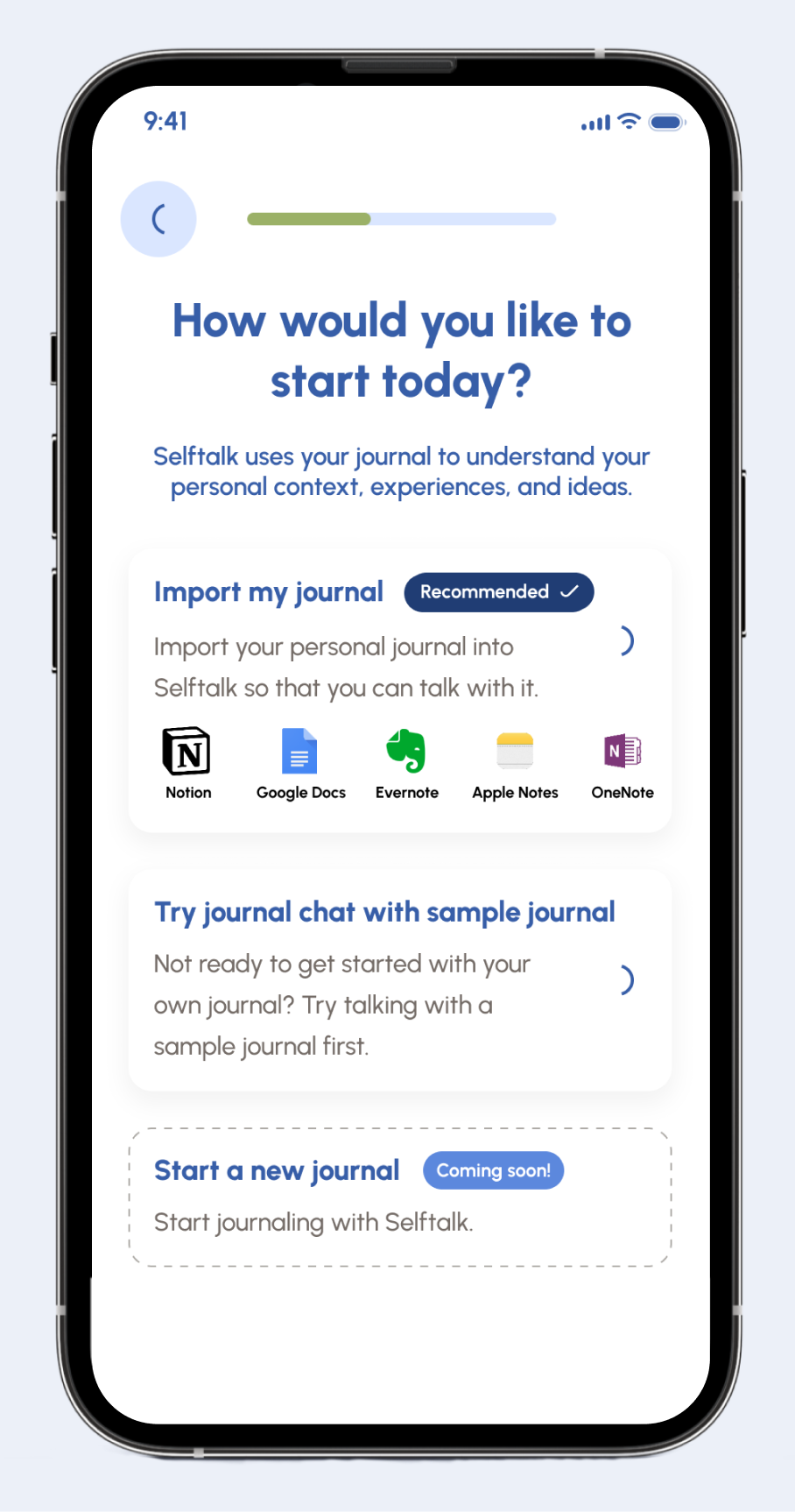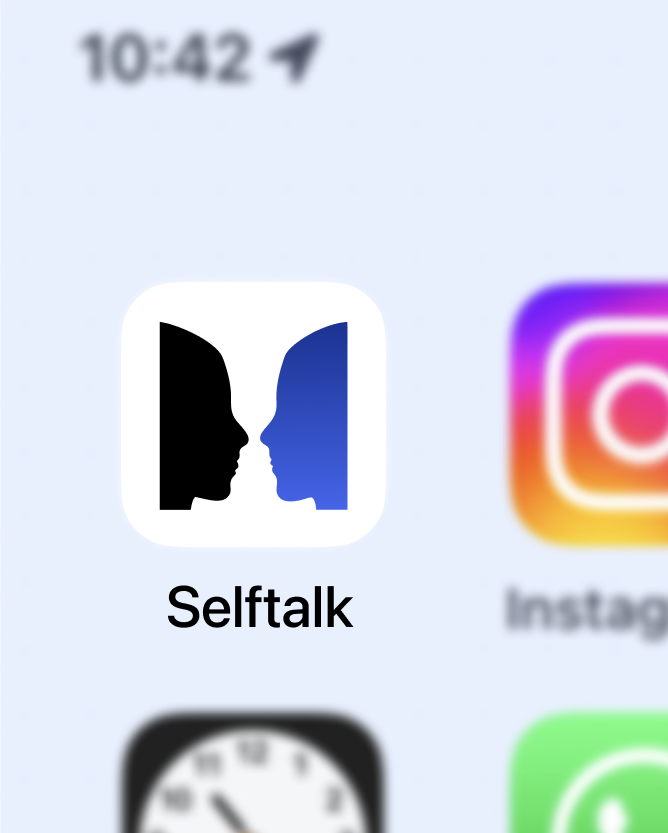Selftalk
Privacy-first mobile app that lets you gain insight from past experiences by talking to your journal.
Part 1 - Design Breakdown
Project summary
Goal: Help people gain insight from their past experiences in order to make good decisions and better understand themselves.
Solution: Let people talk to their journal via a privacy-conscious chatbot.
Status: Prototyped (try it out!)
My role: Everything (ideation, design, prototyping user research, product strategy)
Try a prototype
To try out a prototype of Selftalk, click here or scan the QR code below. It works best on mobile.
Talk to your journal, because no one knows you like you.
Introducing Selftalk, the app that helps you gain insights from your past experiences. It does this by letting you talk with your journal, unlocking insights from personal experiences that you’ve written about but may have forgotten. Selftalk doesn’t give advice, it reflects your own thoughts back to you.
Selftalk does all of this through the use of an AI chatbot that helps you see patterns and celebrate progress. But Selftalk is not just another chatbot, it’s a tool that enables a dialogue with your past, present, and future self. By helping you reflect on, and engage with, past experiences, Selftalk helps you be better prepared for what’s happening now.
Gain insight from your experiences
The goal of Selftalk is to gain insights from your past experiences and thoughts. Users can save “insights” and link them to snippets of any chat or journal entry that inspired the insight. AI-assisted text inputs help users save time.
Before Selftalk, it was too easy to lose track of lessons you learned along the way. Selftalk keeps track of them for you and helps you make sense of them. Plus, Selftalk cites its sources - users can see which chats and/or journal entries each insight came from.
As a product designer, the goal of onboarding is generally to help users quickly realize the product's value. To ensure a smooth onboarding process, Selftalk focuses on users with an existing digital journal that they could easily import.
Getting started with a new app takes time and effort, and I wanted to address some potential reasons why users might drop off from the onboarding process. For users that want to try Selftalk before importing their journal, they can try talking with a sample journal first. And for users that might not be ready to fully switch over to Selftalk for journaling, but don’t want to lose any journaling they do in Selftalk in the meantime, there’s a two-way sync feature.
Getting started with Selftalk
When I first prototyped Selftalk, I designed it for users that have a pen-and-paper journal, for whom the first step would need to be digitizing their journal. My own journal is pen-and-paper, and I took the common route of designing for myself before understanding what real target users do. I even designed a user flow to help users correct mistakes that the computer made while dictating their journal, a problem that I experienced many times. However, when testing the prototype with users, I learned that many users keep a digital journal. I decided to focus on that use case, since that would also allow for a more frictionless onboarding flow.
Customize the chatbot’s tone and personality
Selftalk offers unprecedented control over the chatbot’s tone and personality, ensuring that it can fit a wide variety of users’ needs. Users can choose from 8 preset personalities or customize their own by moving the sliders across various personality traits. The default personality is “Empathetic listener”. AI can potentially make products much more customizable than was previously possible, and I wanted Selftalk to take full advantage.
But because most users don’t change defaults, Selftalk can also update the personality automatically based on how the chat is going. This harnesses AI’s ability to quickly analyze large amounts of data and take actions based on it.
Shareable, but still private
At first, it may seem strange to discuss “sharing” an app like Selftalk. But in practice, we’ll have to grow the product somehow, and organic referrals are a great way to do so. “Sharing Mode” makes it easy to show off Selftalk to friends.
When you activate Sharing Mode by shaking your phone, all sensitive journal and chat data onscreen is replaced with sample data. Using genAI, new test/sample data can be generated on-demand, every time.
Users control their data
With Selftalk, you control what the AI knows about. Say you wrote a journal entry but aren’t ready to talk about it. Simply flip the switch on that journal entry and the AI won’t know about it.
In-app graphics
The in-app graphics for chats and journal entries were manually generated using AI. The distinct styles for journal entries and chats highlight the deeper understanding gained from talking about an experience versus merely writing it down.
This is one of the few parts of this project that is beyond current technological capabilities. It’s more meant to demonstrate generative AI’s potential. No existing AI, to my knowledge, can do a very good job at the task of image curation. This task involves more judgment and opinion than AI is currently capable of. In practice, it involves filtering through numerous subpar images before getting one that is usable.
Using a design system
To ensure a consistent design that I could rapidly iterate on, I chose to use a design system from the Figma community. Coincidentally, the design system was designed for a hypothetical AI journal/therapy app called “Freud”.
I customized the design system to fit the aesthetic I was looking for. For example, I wanted to make the app look more professional, more trustworthy, and less whimsical than the example app. So I used a smaller color palette overall, changed the primary color to navy blue, and made the corners less round across various components.
I also created custom components where necessary. For example, I designed a new variant of the “row” component in order to display lots of information in a more condensed format than what the design system offered out-of-the-box.

























